Del 10 al 15 de febrero se podrá asistir a «The Quiet Volume» de Ant Hampton y Tim Etchells en la Biblioteca Nacional de Catalunya. Se trata de una pieza de autoteatro para dos espectadores. Como introducción, posteamos aquí un artículo que salió publicado el 1 de mayo del 2013 en el New York Times.
The Interior Performance Art
By JENNIFER SCHUESSLER «What is the sound of two heads reading? On Tuesday, in a hushed sixth-floor reading room in New York University’s Bobst Library packed with students cramming for final exams, the answer might have seemed to be: nothing much.But for three pairs of readers scattered among the laptop-laden tables, wearing special headphones hooked up to iPod Nanos and shuffling through a pile of suspiciously literary books, the act of reading was transformed into a strange — and sometimes very loud — drama of turning pages, pointing fingers and eerily drifting thoughts.“The first thing you notice is that for a place dedicated to silence, there’s not really that much silence at all,” a British-accented voice whispered into the readers’ ears. “After a while you start to think that it might be better considered as a place dedicated to the collection of sounds.”The readers, who had signed up in advance, were both the audience and the stars of “The Quiet Volume,” a 55-minute stealth performance piece by the British artists Ant Hampton and Tim Etchells being staged through Sunday by Performance Space 122 as part of the PEN World Voices Festival. (The piece, which also comes in a Spanish-language version, is also running at the Schomburg Center in Harlem.)Regular patrons hardly seemed to notice when the readers turned their books upside down, or ran their fingers in unison under passages in the identical piles of novels in front of them (by José Saramago, Kazuo Ishiguro and Agota Kristof), or flipped through a book of depopulated cityscapes by the photographer Gabriele Basilico, or just stared at a blank page in a spiral-bound notebook.
The mental action, however, was far more disorienting and sometimes edged toward violence. Readers turned to passages containing words like “strangulation,” “saboteurs” and “death sentence,” which were subtly altered by a voice reading along, or overwhelmed by a tide of white noise. They were asked to imagine all the books in a huge library cut up into their individual words, then separated into huge drawers reading “knife,” “cloud” or “the.”
At one point, books slammed shut from an uncannily precise location a few feet to the listeners’ left — inside the headphones, or outside in the real-life library? — causing the listener to brace for a librarian’s angry “Shhhhh!”
The cumulative effect was to make you wonder what kind of frozen sea was really breaking inside the earbud-wearing guy at the next table, hunched over “Essentials of Importing and Exporting.”
“The whole thing made you think about the nature of your sensory experience while reading, the relationship between the voice in your head and the words on the page,” said Jessica Harris, a graduate student who had just finished performing the piece with a friend.
One goal of “autoteatro,” as Mr. Hampton, 37, calls the self-enacted theater pieces he began creating in 2007, is to blur the distinction between presence and absence, inside and outside, reality and imagination, art and the real world.»

